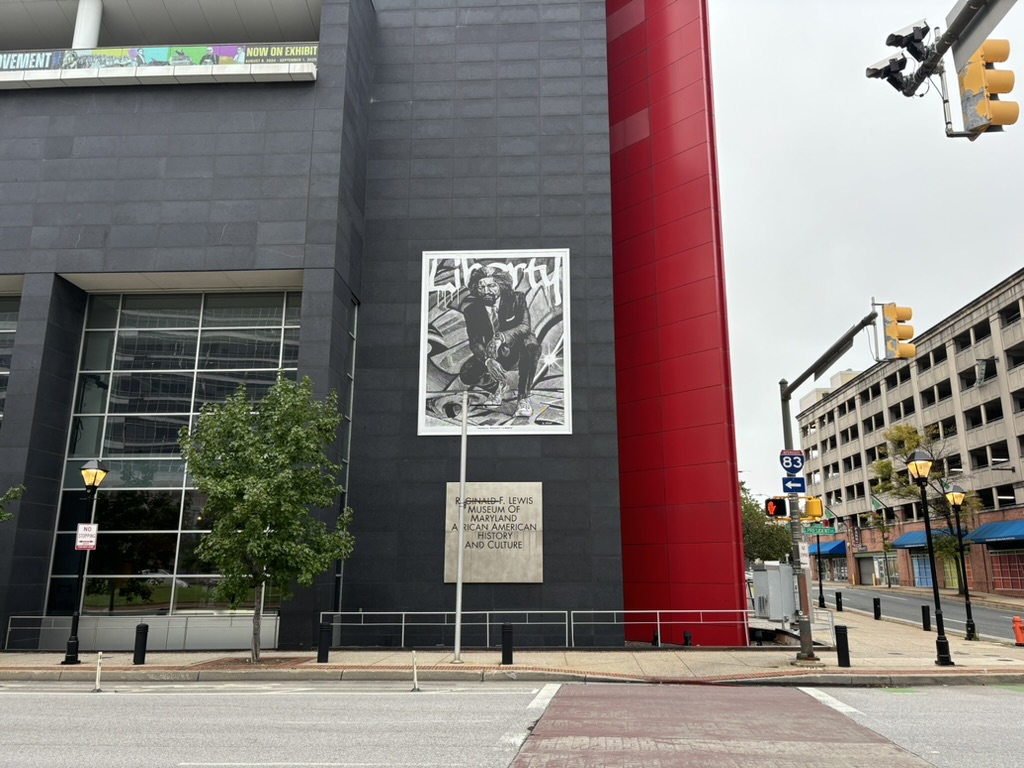
Take a drive down President Street this week and you’ll notice a new banner of Frederick Douglass gracing the side of the Reginald F. Lewis Museum—but this is a Douglass you likely haven’t seen before.
The portrait of the iconic abolitionist—who was born into slavery on Maryland’s Eastern Shore and spent years working in the Fells Point shipyards before escaping to freedom in 1838—is two stories tall and depicts him dressed in a modern suit and Converse sneakers, flashing a fancy watch, and popping a “rap squat.” It’s an image that Lewis Museum President Terri Lee Freeman hopes will provoke conversation about race, art, and identity.
Titled Liberty, the banner is a reproduction of a linocut crafted by Utah-based entrepreneur-turned-artist Adam Himoff, who is white. It ignited a flare up of local controversy when it was displayed last November in Easton, near where Douglass was born.
One of the most photographed people of the 19th century, Douglass wrote about his belief that dignified images of Black people could challenge race perceptions and work in favor of abolition. Some community members found Himoff’s contemporary portrayal of Douglass to be disrespectful and publicly called for its removal.
“Frederick Douglass never wanted to be viewed as an amiable slave or viewed as a Black man on his knees,” Tarence Bailey, a Douglass descendant, told the Washington Post last year.
But Himoff says the goal of the work is to bring Douglass into the present and to “wonder about who this great man might be if he were still alive.”
“How would he live, how would he dress, and, most importantly, what work would he be doing today to fight injustice and prejudice?” Himoff tells us. “The fact that people are debating what pose he would be in or what type of sneakers he’d be wearing means that people are doing the work of actively reflecting on his powerful legacy—and that’s fantastic.”
So far in Baltimore, the response has been largely positive, as indicated by the 300-plus likes that an image of the work first received on the museum’s Instagram.
“I really like the ‘new school’ aesthetic,” Baltimore native Jackson Montgomery, 20, told us when asked his opinion outside of the museum last weekend. “It relates to us more. We only know him through the history books, so I mess with it.”
His friends Brandon Stevens, 19, and Jabar Whitehead, 19, concurred. “It shows what he’d be like nowadays,” Stevens added.
The museum also took to the streets earlier this week to seek feedback from local residents. The resulting video captures young Baltimoreans responding to the image with enthusiasm, while an elderly man laments Douglass’s footwear.
But opinions have ultimately varied, regardless of age. “[Douglass] wanted to challenge racist stereotypes about what it meant to be Black,” commented one Instagram user. “Some might argue that this image is directly what he was pushing back against.”
According to Lewis Museum president Freeman, this mix of reactions can be a good thing, as far as getting people to think and talk about race.
“I really want people to look at it as they’re driving down the street and go, ‘Wow,'” she says. “Then go home and say, ‘I just saw this portrait and I don’t know how I feel—is it really cool, or should I feel some kind of way?’”
Liberty will be on display through February 2025. Meanwhile, the Lewis Museum is making plans for public forums with the artist and other subject matter experts to discuss the ways that race and identity impact the work’s themes.
When asked if the artist’s race matters in this context, Freeman responds, “I really liked the work, and I admit I was a little taken aback when I learned the artist was white. But then I had to ask myself—why? In the end, these are exactly the kinds of questions we’re hoping to encourage.”
